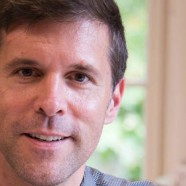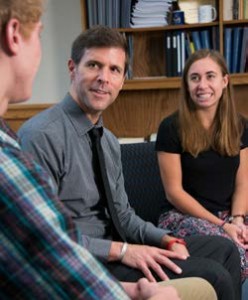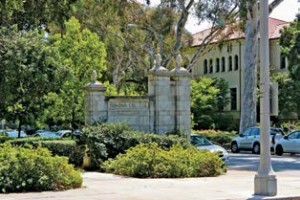
“I’m interested in stretching the notion of what ‘deserving’ means in this day and age,” Seth Allen ’86 says, one day in June when his normally teeming office is unduly quiet. Seth is vice president and dean of admission and financial aid at Pomona College, and he’s directing his comment at college admission overall. As a process, applying and getting accepted to college provokes fixation, incredulity and frustration for many families, nationwide. It also raises urgent questions about access, affordability and value.
“Four years at Pomona and now in my 25th year in the field, I’d say that no one thinks of himself as a future admission officer,” Seth ventures. Without planning to, Seth launched his career at his alma mater, Johns Hopkins. He gained responsibility and visibility quickly, directing admission at Dickinson (eight years), and adding financial aid oversight to his admissions work at Grinnell (eight years) prior to arriving at Pomona in 2011. He likes the job. “I get to meet the brightest young people, travel around the world, talk about issues that matter, and think creatively,” he says.
Other aspects of his job are less straightforward. He navigates numerous, intersecting, often interdependent, sets of metrics: The arbitrary and inexplicable algorithms that deliver college rankings are one set. (Pomona ranks fifth among small liberal arts colleges in U.S. News and World Report.) Pomona’s institutional goals are another: What continuing increase in applications, or decrease in percent of yield, or numbers of students who receive financial assistance represent sound policy for Pomona? Seth’s personal goals mark a third area: What numbers mean “success” in his own mind’s eye?
 In 1990, Seth imagined leveraging his Hopkins B.A. in economics to secure a launching pad in finance or in consulting. At the time, a mini-recession served up an abundance of freshly minted M.B.A.s in Boston and New York, as eager as they were overqualified for the open entry-level jobs, so Seth revised his strategy. The admission office at Hopkins, where he had worked as an undergrad, welcomed him back, and with that vantage point, he planned to enter the financial sector through Baltimore connections. Reading applicants’ files and helping the committees charged with choosing the next class “turned him on,” however, and he took an open position at Hopkins in 1991, promising a two-year stay.
In 1990, Seth imagined leveraging his Hopkins B.A. in economics to secure a launching pad in finance or in consulting. At the time, a mini-recession served up an abundance of freshly minted M.B.A.s in Boston and New York, as eager as they were overqualified for the open entry-level jobs, so Seth revised his strategy. The admission office at Hopkins, where he had worked as an undergrad, welcomed him back, and with that vantage point, he planned to enter the financial sector through Baltimore connections. Reading applicants’ files and helping the committees charged with choosing the next class “turned him on,” however, and he took an open position at Hopkins in 1991, promising a two-year stay.
At two points, Seth “tried” to migrate away from admission. While pursuing a master’s degree in change management at Hopkins (1995–97), he moved into institutional research there. That deep dive into analysis and strategy rekindled his love for data and for economics. Working with another Hopkins grad, he also developed an online application, which ultimately led to the online common college application and an invitation from IBM to join the firm as a consultant. Seth walked through other open doors, however — in Pennsylvania, Iowa and California.
His years of admission experience have led to a public commitment to change the process. “How do we, in an equitable way, identify the most-deserving students?” Seth asks pointedly. “I think we have inadequate tools.”
He points out that the system colleges use to select students, more than six decades old, was developed as an exclusionary system for a smaller, homogeneous, affluent population. “We have spent lots of energy doing end runs around this system, adapting it so that it’s more positive, but it doesn’t work particularly well.
“We’ve become both panderers to and victims of ranking systems that tell us how to think about our colleges and universities in a very artificial way.” They set up far too narrow and convenient a definition of what success is, he believes. It’s not that rankings have no value, but more that they’re only a start, in his view. And he points to bigger concerns: the unsustainable cost of higher education, and the issue of which young people are even able to consider the idea of college.
Research about how young people develop has advanced, Seth notes. “We have learned that there are different kinds of intelligences. We have access to information that helps us understand kids, what makes them tick, what turns them on, what helps them become all that they can be. That’s the kind of information that’s desirable when you’re trying to make a class.”
 Which institutions are rewarded by the current admission process, and what might incentivize them to change a system that rewards them so well? Colleges and universities feel plenty of pressure: tinkering with the barometer that measures you is risky. “Yet colleges that do introduce some experimentation stand to learn so much,” Seth argues. “They will, over time, more effectively distill who this student is, who will thrive in a certain environment.”
Which institutions are rewarded by the current admission process, and what might incentivize them to change a system that rewards them so well? Colleges and universities feel plenty of pressure: tinkering with the barometer that measures you is risky. “Yet colleges that do introduce some experimentation stand to learn so much,” Seth argues. “They will, over time, more effectively distill who this student is, who will thrive in a certain environment.”
Sticking with the status quo strengthens unintentional messages about what colleges value, according to Seth. “Students, their schools and their parents are not allowing or promoting kids’ taking risks. The great irony is that teenagers who are petrified of making mistakes, who don’t lean in to creative, divergent thinking, are least attractive to us. Students don’t seem to have the freedom to be themselves, while admission officers are trying to find out Who are you, really? We’re really interested in those 17-year-olds who are vulnerable, but self-aware,” says Seth, “kids that have the potential for being exciting, not just passive passengers.”
Seth is involved in a number of efforts, including exploring, with a coalition of private and public institutions, the possibility of creating a new, shared application, an alternative to the Common Application. This system, tentatively scheduled to debut in 2016, according to Eric Hooter in The Chronicle of Higher Education, could change how many students apply to college. Coalition members see this platform as an effort to reach out to high-achieving students who lack financial resources. “It’s looking at college admission as a multi-year process,” Seth explains, “setting up a longer horizon, allowing for progress, providing intelligent advising, and making sure that community-based organizations that help kids consider college have the resources and the tools to be effective.” The coalition wants the product to broaden awareness, promote better access, offer a realistic process for young people to consider college. “In the next phase of my career,” Seth says, “I’m eager to lend my time and attention to push the agenda and the boundaries in areas where I’ve been a believer, to stop talking and start solving.”
by Cathleen Everett



